What new challenges will preservationists face over the next 50 years? It’s clear that the impacts on historic places by hurricanes Katrina and Sandy and other recent tropical storms, combined with growing international concern about rising sea levels, has started to “change the tide” and bring a new focus to preservation professionals. In April and June 2016, national and international experts in historic preservation, climate change, emergency management, architecture, and planning gathered in three U.S. states to participate in a series of “firsts” to address the threats facing the nation’s historic coastal and riverine (meaning ‘situated or dwelling beside a river’) communities from flooding and climate change. I was excited to represent the PASHPO and our Disaster Planning for Historic Properties Initiative at each of these three groundbreaking events: the Keeping History Above Water conference in Newport, Rhode Island; the Weather-It-Together Sea Level Rise Planning Charrette in Annapolis, Maryland; and the Symposium on Flooding and Pennsylvania’s Historic River Towns in Lewisburg, Pennsylvania as part of the 2016 Statewide Conference on Heritage.
Within the last five or so years, the preservation community has started talking more and more about the damage that has been done – and will be done – to the historic properties (buildings and archaeological sites alike) through climate change. Awareness about these natural threats will likely continue to expand as storms grow in intensity and frequency as projected by climate scientists, including those here in Pennsylvania. As researchers from Penn State University’s Environmental & Natural Resources Institute (ENRI) explain, “There are substantial and increasing [inland and coastal] flood risks in Pennsylvania for both urban areas and infrastructure in rural areas. Adaptation strategies that focus on increasing flood preparedness, reducing vulnerabilities, and increasing resilience in more extreme and more frequent flooding scenarios are of high priority.” (See ENRI’s May 2015 Pennsylvania Climate Impacts Assessment Update, prepared for the PA Department of Environmental Protection, for more details.) It is important that historic places are not only included, but prioritized, in such strategies due to the vital role they play in communities’ unique cultural identity and sense-of-place.
Each of the three events I am going to talk about below was very timely and their locations apropos: they are responding to the urgent climate change issues of sea-level-rise and increasingly frequent and severe riverine flooding, and they were convened this year while the preservation community is celebrating the 50th anniversary of the National Historic Preservation Act of 1966. As we celebrate that important legislation, which facilitated the preservation of so many historic places throughout the Keystone State and the nation, the preservation community looks back at the successes and challenges of the last half century. This milestone year also presents an opportunity for the preservation community to look forward to the next 50 years and discuss new challenges to preserving America’s historic built environment and important archaeological sites. Climate change is at the forefront of our 21st century challenges and the three “firsts” I discuss below have given us a strong start in addressing the problem.
Keeping History Above Water, April 10-13 (Newport, RI)
This conference was organized by the Newport Restoration Foundation and hosted in a city that lays claim to one of the largest concentrations of remaining colonial-era buildings in the U.S. and is threatened by climate change. It attracted a wide range of experts and innovators from around the United States and abroad from places that experience frequent flooding and/or have begun recently experiencing the impacts of a changing global climate, particularly rising sea levels; these places include New Orleans, Boston, Annapolis, Galveston, Scotland, the Netherlands, Venice, Iran, and others. Keeping History Above Water did not address the causes of climate change, but rather how historic communities can and should address its associated flooding impacts, and called for out-of-the-box solutions necessary to reduce risk while preserving historic character. Highlights of the conference, for me, included the following:
- Learning about one very out-of-the-box (and apparently feasible) flood mitigation measure that could be employed for historic buildings that would allow a building to float on the surface of rising floodwaters rather than become inundated—see the Buoyant Foundation Project to learn more about “amphibious architecture”!
- A walking tour of one of Newport’s earliest settled neighborhoods, The Point, which is slowly being consumed by the sea through the course of regular and increasingly severe high-tide flooding. One of The Point buildings, the circa-1728 home of colonial-era cabinetmaker Christopher Townsend at 74 Bridge Street, served as a primary case study throughout the 4-day conference and I had the opportunity to participate in an intensive planning workshop to identify sensitive solutions for its preservation.
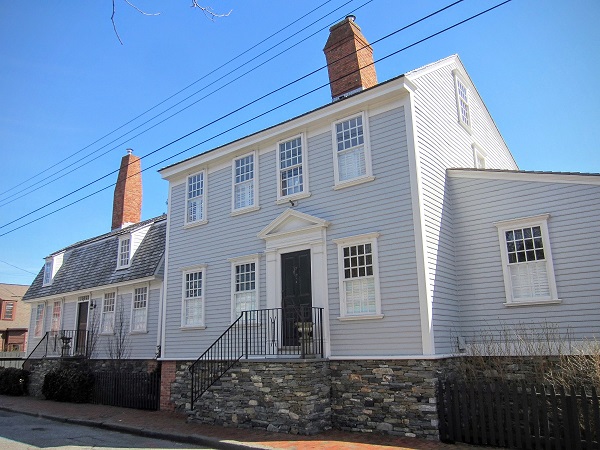
This 18th century residence on Bridge Street in Newport, Rhode Island’s historic Point Neighborhood was a source of controversy and a catalyst for the April 2016 Keeping History Above Water conference when it was elevated by the current owners to better protect it from recurring coastal flooding. The top photo is the historic residence in 2012, situated at grade; the bottom photo is the residence in 2016, perched upon a 4’9”-high stone foundation above the base flood elevation (100-year flood level).
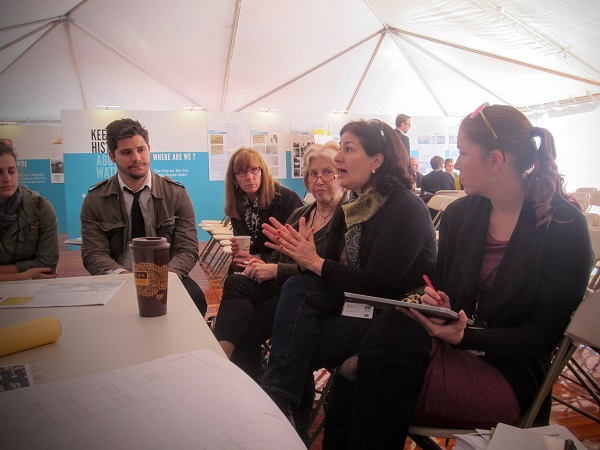
Participants of a breakout group focused on “Understanding and Adapting Building Codes and Environmental Regulations” at a planning workshop held at the Christopher Townsend House (74 Bridge Street), held on the final day of the “Keeping History Above Water” conference in Newport, Rhode Island.
On the 3rd day of the conference, I spoke to the audience of over 300 attendees about the Philadelphia pilot project of the PASHPO’s Disaster Planning for Historic Properties Initiative, which was relevant to the conversation as Philadelphia, like Newport, is vulnerable to rising sea levels and tropical storm surge. I also explained the importance of including current information about historic places in local and state hazard mitigation plans (HMP) for planning purposes. HMPs that include strategies for protecting historic resources could open the door for communities to receive federal funding to implement flood protection measures for their historic building stock.
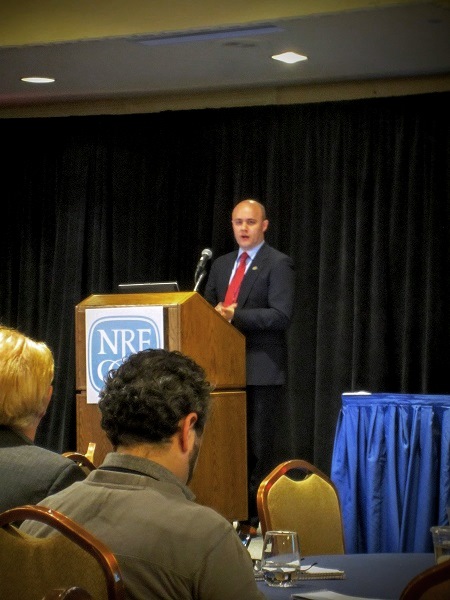
Jeremy Young, Project Manager of the PA SHPO’s Disaster Planning for Historic Properties Initiative, addresses the audience at the “Keeping History Above Water” conference in Newport, Rhode Island on April 12, and discusses the importance of integrating information about historic places into FEMA-approved local and state hazard mitigation plans. Photograph by Sarah Sutton, 2016.
You can learn more about this groundbreaking event, including about the content and speakers, by visiting the conference’s website at historyabovewater.org.
Weather-It-Together Sea Level Rise Planning Charrette, April 30 (Annapolis, MD)
The historic state capital city of Annapolis, Maryland, like Newport, Rhode Island, retains much of its early colonial-era building stock and shares another unfortunate similarity with Newport: its high vulnerability to sea level rise and increasingly frequent tidal flooding. On Saturday, April 30, the City of Annapolis, under the leadership of Historic Preservation Chief Lisa Craig, held a day-long public charrette (an intensive planning and design workshop) to identify creative and effective solutions to preserve the city’s historic downtown seaport from the rising Chesapeake Bay. Over 100 people were in attendance, from ordinary citizens to professional experts. The charrette was part of the City of Annapolis’ larger Weather-It-Together initiative, sponsored by the National Trust for Historic Preservation, the Urban Land Institute, and other organizations, that focuses on the development of a Cultural Resources Hazard Mitigation Plan; one of the first such plans in the nation.
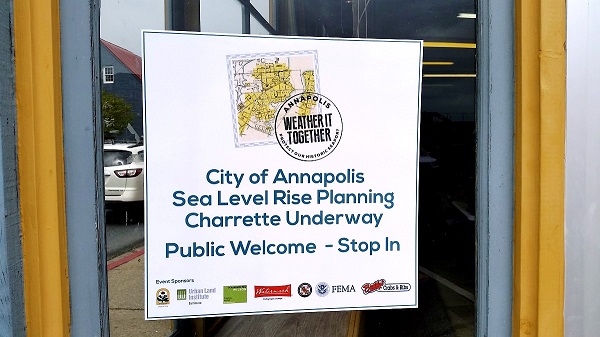
Sign inviting members of the public to participate in the April 30 Weather-It-Together Sea Level Rise Planning Charrette at Annapolis, Maryland’s historic seaport.
I was invited by Lisa, one of the PASHPO’s key across-state-lines partners in our effort to identify sensitive risk reduction measures for the Keystone State’s flood-prone historic communities, to serve as a table moderator for the break-out sessions. I joined Nell Ziehl, Chief of the Office of Planning, Education and Outreach at the Maryland Historical Trust, at a break-out group table focused on “Cultural Resource Impacts: Adaptation Strategies.” We collected input from concerned residents, officials, and experts in historic preservation and flood mitigation and explored alternatives, such as retrofits to keep water out of buildings (“dry floodproofing”), retrofits to invite water in (“wet floodproofing”), elevating historic buildings, and relocation.
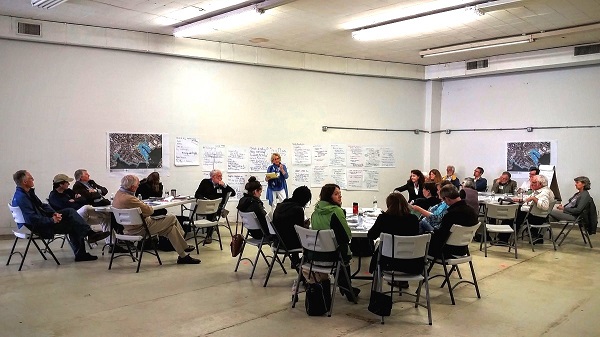
Participants in break-out groups at the Weather-It-Together Sea Level Rise Planning Charrette in historic Annapolis, Maryland on April 30.
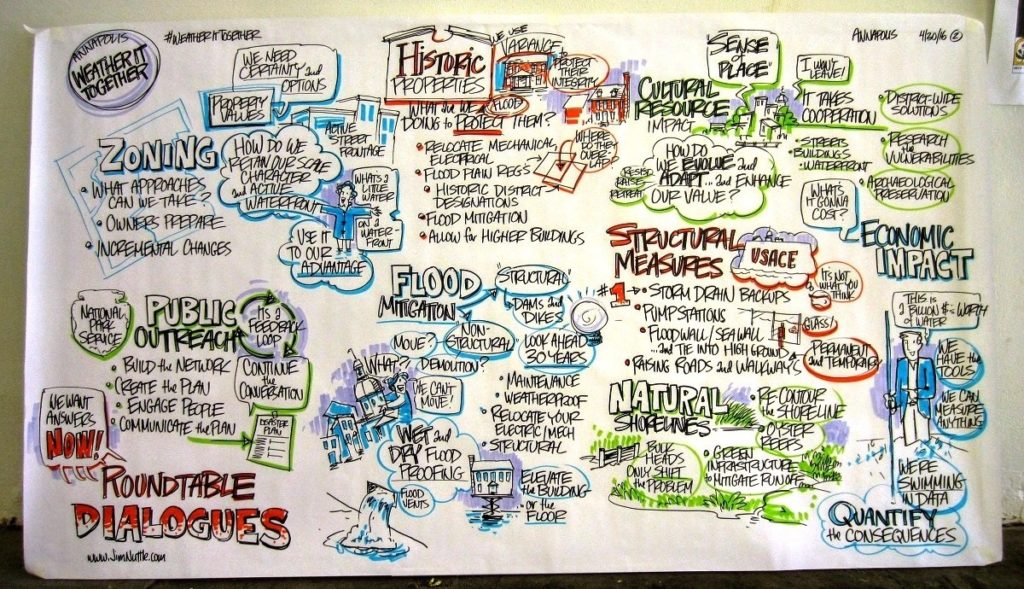
One of several visual summaries produced by graphic recorder Jim Nuttle of the ideas and dialogues heard during the Weather-It-Together Sea Level Rise Planning Charrette in Annapolis, Maryland on April 30.
You can learn more about the Weather-It-Together Sea Level Rise Planning Charrette and the topics that were explored that day by viewing this slideshow from the City of Annapolis.
Symposium on Flooding and Pennsylvania’s Historic River Towns, June 8 (Lewisburg, PA)
Last month, the third of the 3 major forums in the northeastern United States focused on the impacts of flooding on historic communities was held right here in the Keystone State. The first-ever Symposium on Flooding and Pennsylvania’s Historic River Towns was held in the charming and flood-prone Borough of Lewisburg, Union County, where nearly 40% of the historic district is in the 100-year floodplain of the Susquehanna River. This day-long event was organized and sponsored largely by the PASHPO and Preservation Pennsylvania and was held on the final day of the 2016 Statewide Conference on Heritage.
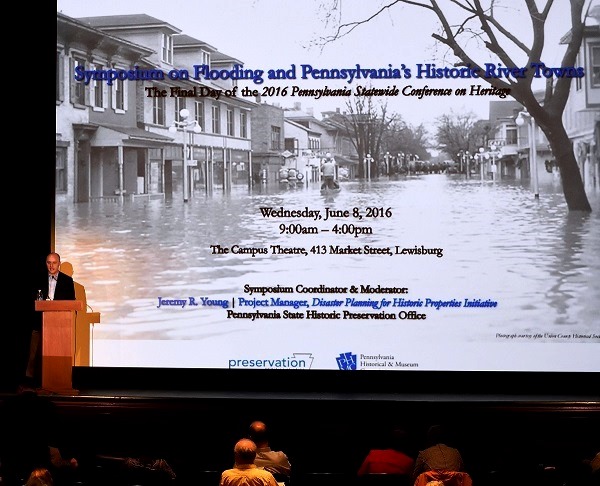
Moderator Jeremy Young of the PASHPO kicks off the first-of-its-kind Symposium on Flooding and Pennsylvania’s Historic River Towns in the historic Campus Theatre in downtown Lewisburg, Union County, on June 8. Photo by Don Giles/PHMC.
Unlike the events in Annapolis and Newport that focused on coastal/tidal flooding, this ground-breaking convening focused on inland riverine flooding, an issue that affects hundreds of historic riverine communities in Pennsylvania. The Commonwealth is one of the most flood-prone and flood-damaged states in the nation from because of its large and numerous rivers and streams that crisscross the land; in 2014, Pennsylvania ranked 3rd in the nation for dollars paid from the National Flood Insurance Program to riverine communities in the state. The symposium was designed to do a couple of key things: (1) raise awareness about the challenges historic Pennsylvania communities face in addressing and planning for flooding, particularly the magnitude of the impacts of flooding, and (2) present solutions for reducing historic buildings’ risk from flooding in a way that will result in minimal impacts to their character and integrity.
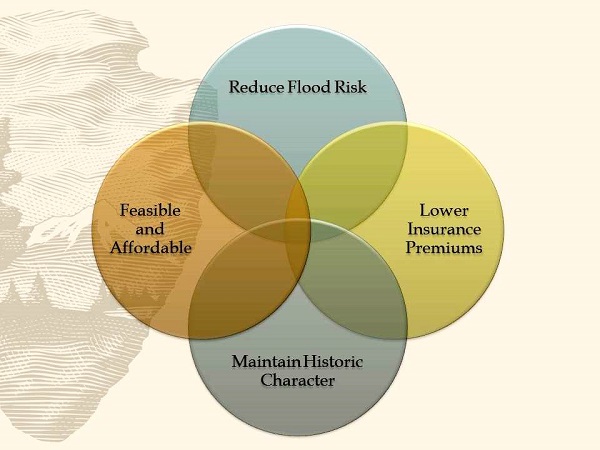
This Venn diagram, courtesy of Jenny Parker and Jenifer Eggleston of the National Park Service, speakers at the June 8 Symposium on Flooding and Pennsylvania’s Historic River Towns, illustrates the four primary and overlapping goals of flood mitigation for historic communities.
As both the event organizer and moderator, I was very pleased with the quality and depth of each of the speakers’ presentations. The panel of speakers and the content of their presentations were very broad, and reflected the diversity of the audience of nearly 100 attendees, ranging from preservationists, emergency managers, planners, architects, to local officials. The day’s discussion also focused on the impacts of recent federal flood insurance reform, which could theoretically have dire consequences for PA’s river towns. Flood insurance premiums, formerly subsidized by the federal government for older buildings constructed in the floodplains before floodplain management regulations were enacted, are now rapidly rising to reflect their actual risk from flooding. Some are concerned that these changes and dramatic increases in annual flood insurance premiums could result in property owners walking away from their mortgages and whole sections of communities emptying out, resulting in municipalities losing large portions of their tax base and a whole new wave of property neglect and blight in Pennsylvania communities. Many preservationists are concerned about the impacts this will have on the long-term preservation of historic districts and other historic places located adjacent to rivers and streams.
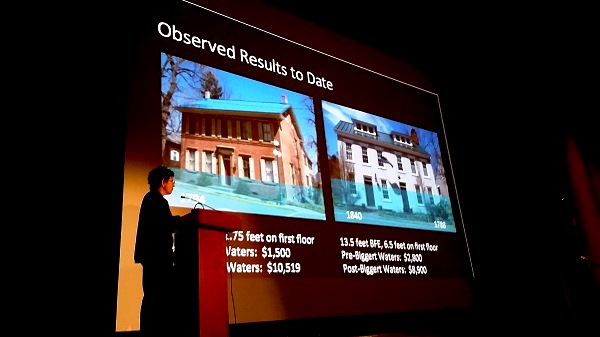
Samantha Pearson, Executive Director of the Lewisburg Neighborhoods Corporation and speaker at the June 8 Symposium on Flooding and Pennsylvania’s Historic River Towns, explains the impacts of rapidly rising flood insurance premiums already experienced in historic Lewisburg Borough, Union County.
Overall, since the June 8 Symposium, we have received a great deal of positive feedback from attendees. It is my hope that emergency managers left feeling much more knowledgeable about historic preservation issues and vice-versa, and that county and municipal representatives left with an understanding of new approaches that could be undertaken in their communities to reduce flood risk yet effectively preserve their historic building stock. In order to address these issues effectively, there must be a level playing field and various disciplines, as well as all levels of government, must work together.
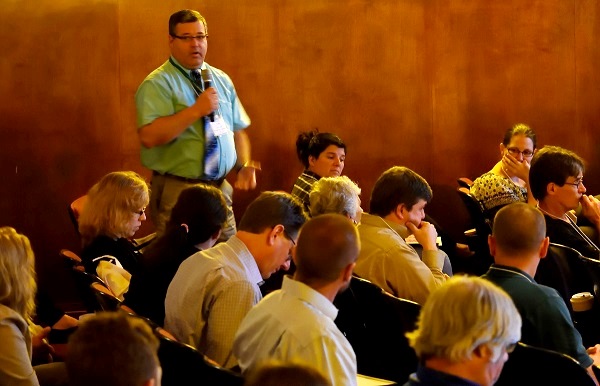
State Hazard Mitigation Officer Tom Hughes of the Pennsylvania Emergency Management Agency (PEMA) addresses the audience during one of several Q&As at the Symposium on Flooding and Pennsylvania’s Historic River Towns on June 8 in Lewisburg.
If you’re interested in learning more about the symposium’s content, or were interested in attending but unable, speaker slideshows are available for viewing and download via Preservation Pennsylvania’s Statewide Conference on Heritage website under “Flood Symposium”.
The events of April and June 2016 made huge strides in not only helping to shed light on the increasing vulnerability of our nation’s historic coastal and riverine communities to flooding, but also on the development of multidisciplinary coalitions to begin solving the complex issue of how to preserve these places through the use of flood risk reduction measures that are effective but also sensitive to the character and integrity of the resources.
This material is based upon work assisted by a grant from the U.S. Department of the Interior, National Park Service. Any opinions, findings, and conclusions or recommendations expressed in this material are those of the author(s) and do not necessarily reflect the views of the U.S. Department of the Interior.

Leave a Reply